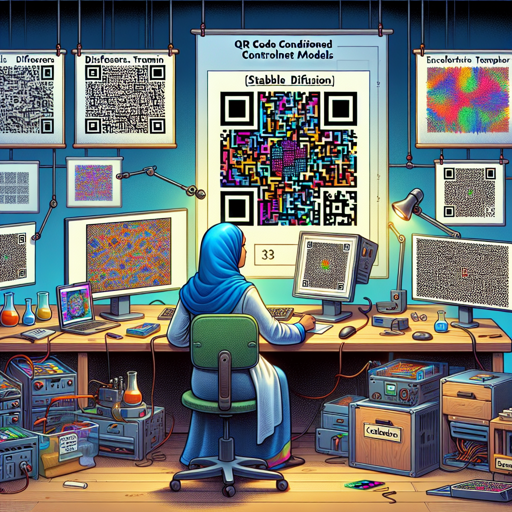If you’re looking to create stunning QR code-based artwork, you’re in the right place! In this guide, we’ll walk you through utilizing the ControlNet models trained specifically for generating aesthetically pleasing QR codes with the Stable Diffusion 1.5 and 2.1 frameworks.
Understanding ControlNet Models
Think of the ControlNet models as a skilled artist who knows how to blend creativity with structure. You start with a QR code—the canvas—and your artwork is the design that will be superimposed. Just like an artist needs to maintain the integrity of a canvas while painting, these models ensure that the QR code’s structure remains intact while enhancing its visual appeal.
Installation Requirements
Before diving into the usage, ensure you have the necessary libraries installed:
- diffusers
- transformers
- accelerate
- torch
- xformers
Execute the following command in your terminal:
pip -q install diffusers transformers accelerate torch xformersStep-by-Step Instructions
Follow these simple steps to get started with the ControlNet models:
1. Import Libraries
Begin by importing the necessary libraries:
import torch
from PIL import Image
from diffusers import StableDiffusionControlNetImg2ImgPipeline, ControlNetModel, DDIMScheduler
from diffusers.utils import load_image2. Load Your Model
Depending on the Stable Diffusion version you’re using (1.5 or 2.1), load the ControlNet model by adjusting the following command:
controlnet = ControlNetModel.from_pretrained('DionTimmer/controlnet_qrcode-control_v1p_sd15', torch_dtype=torch.float16)3. Set Up the Pipeline
Now, create a Stable Diffusion image generation pipeline:
pipe = StableDiffusionControlNetImg2ImgPipeline.from_pretrained(
'runwayml/stable-diffusion-v1-5',
controlnet=controlnet,
safety_checker=None,
torch_dtype=torch.float16
)4. Optimize Memory**
Enable efficient memory attention and model CPU offloading:
pipe.enable_xformers_memory_efficient_attention()
pipe.scheduler = DDIMScheduler.from_config(pipe.scheduler.config)
pipe.enable_model_cpu_offload()5. Prepare Your Images
Resize images appropriately so that they work seamlessly with the ControlNet models:
def resize_for_condition_image(input_image: Image, resolution: int):
input_image = input_image.convert('RGB')
W, H = input_image.size
k = float(resolution) / min(H, W)
H *= k
W *= k
H = int(round(H / 64.0)) * 64
W = int(round(W / 64.0)) * 64
img = input_image.resize((W, H), resample=Image.LANCZOS)
return img6. Generate Your Artwork
Finally, use your setup to generate QR code artwork:
source_image = load_image('https://s3.amazonaws.com/moonup/production/uploads/6064e095abd8d3692e3e2ed6A_RqHaAM6YHBodPLwqtjn.png')
init_image = load_image('https://s3.amazonaws.com/moonup/production/uploads/noauth/KfMBABpOwIuNolv1pe3qX.jpeg')
condition_image = resize_for_condition_image(source_image, 768)
init_image = resize_for_condition_image(init_image, 768)
generator = torch.manual_seed(123121231)
image = pipe(prompt='a billboard in NYC with a QR code',
negative_prompt='ugly, disfigured, low quality, blurry, nsfw',
image=init_image,
control_image=condition_image,
width=768,
height=768,
guidance_scale=20,
controlnet_conditioning_scale=1.5,
generator=generator,
strength=0.9,
num_inference_steps=150)
image.images[0]Performance and Limitations
While the ControlNet models perform admirably, be aware that they are not infallible. A QR code may occasionally lose its shape. If this happens, try increasing the ControlNet weight; however, do this cautiously to maintain artistic integrity. Aim to generate QR codes with correction mode H (30%) to optimize scanning. Fine-tuning may be required depending on your input and desired output.
Troubleshooting Tips
If you encounter issues or your output isn’t as expected, here are some troubleshooting ideas:
- Ensure that your input images are correctly formatted and not corrupted.
- Double-check the model path and ensure you have the right version of Stable Diffusion loaded.
- Experiment with different values for
guidance_scaleandcontrolnet_conditioning_scale. - Consult additional resources on using ControlNet in case of confusion.
For more insights, updates, or to collaborate on AI development projects, stay connected with fxis.ai.
Final Thoughts
At fxis.ai, we believe that such advancements are crucial for the future of AI, as they enable more comprehensive and effective solutions. Our team is continually exploring new methodologies to push the envelope in artificial intelligence, ensuring that our clients benefit from the latest technological innovations.

